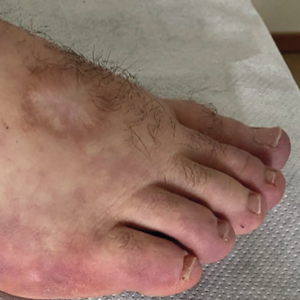Vasculitis associated with adenosine deaminase 2 deficiency: at the crossroads between Behçet’s disease and autoinflammation. A viewpoint

Submitted: 21 March 2023
Accepted: 28 June 2023
Published: 18 September 2023
Accepted: 28 June 2023
Abstract Views: 1445
PDF: 637
Publisher's note
All claims expressed in this article are solely those of the authors and do not necessarily represent those of their affiliated organizations, or those of the publisher, the editors and the reviewers. Any product that may be evaluated in this article or claim that may be made by its manufacturer is not guaranteed or endorsed by the publisher.
All claims expressed in this article are solely those of the authors and do not necessarily represent those of their affiliated organizations, or those of the publisher, the editors and the reviewers. Any product that may be evaluated in this article or claim that may be made by its manufacturer is not guaranteed or endorsed by the publisher.
Similar Articles
- Y. Emad, T. Gheita, H. Darweesh, P. Klooster, R. Gamal, H. Fathi, N. El-Shaarawy, M. Gamil, M. Hawass, R.M. El-Refai, H. Al-Hanafi, S. Abd-Ellatif, A. Ismail, J. Rasker, Antibodies to extractable nuclear antigens (ENAS) in systemic lupus erythematosus patients: correlations with clinical manifestations and disease activity , Reumatismo: Vol. 70 No. 2 (2018)
- M. Rossini, O. Viapiana, M. Vitiello, N. Malavolta, G. La Montagna, S. Maddali Bongi, O. Di Munno, R. Nuti, C.U. Manzini, C. Ferri, L. Bogliolo, A. Mathieu, F. Cantatore, A. Del Puente, M. Muratore, W. Grassi, B. Frediani, G. Saviola, P. Delvino, L. Mirone, G. Ferraccioli, G. Tripi, I. Piazza, D. Gatti, Prevalence and incidence of osteoporotic fractures in patients on long-term glucocorticoid treatment for rheumatic diseases: the Glucocorticoid Induced OsTeoporosis TOol (GIOTTO) study , Reumatismo: Vol. 69 No. 1 (2017)
- M. Romano, I. Pontikaki, M. Gattinara, I. Ardoino, C. Donati, P. Boracchi, P.L. Meroni, V. Gerloni, Drug survival and reasons for discontinuation of the first course of biological therapy in 301 juvenile idiopathic arthritis patients , Reumatismo: Vol. 65 No. 6 (2013)
- M. Rossini, S. Adami, F. Bertoldo, D. Diacinti, D. Gatti, S. Giannini, A. Giusti, N. Malavolta, S. Minisola, G. Osella, M. Pedrazzoni, L. Sinigaglia, O. Viapiana, G. C. Isaia, Guidelines for the diagnosis, prevention and management of osteoporosis , Reumatismo: Vol. 68 No. 1 (2016)
- L. Cantarini, A. Vitale, O.M. Lucherini, I. Muscari, F. Magnotti, G. Brizi, B. Frediani, G.D. Sebastiani, M. Galeazzi, D. Rigante, Childhood versus adulthood-onset autoinflammatory disorders: myths and truths intertwined , Reumatismo: Vol. 65 No. 2 (2013)
- J. Mencarini, M. Spinicci, F. Bartalesi, Risk of cytomegalovirus reactivation in patients with immune-mediated inflammatory diseases undergoing biologic treatment: a real matter? , Reumatismo: Vol. 68 No. 3 (2016)
- S.L. Bello, L. Serafino, C. Bonali, N. Terlizzi, C. Fanizza, C. Anecchino, G. Lapaldula, Incidence of influenza-like illness into a cohort of patients affected by chronic inflammatory rheumatism and treated with biological agents , Reumatismo: Vol. 64 No. 5 (2012)
- M. Rossini, G. D'Avola, M. Muratore, N. Malavolta, F. Silveri, G. Bianchi, B. Frediani, G. Minisola, M. L. Sorgi, M. Varenna, R. Foti, G. Tartarelli, G. Orsolini, S. Adami, Regional differences of vitamin D deficiency in rheumatoid arthritis patients in Italy , Reumatismo: Vol. 65 No. 3 (2013)
- F.M. Perrotta, O. Addimanda, R. Ramonda, S. D’Angelo, E. Lubrano, A. Marchesoni, I. Olivieri, L. Punzi, C. Salvarani, A. Spadaro, Predictive factors for partial remission according to the Ankylosing Spondylitis Assessment Study working group in patients with ankylosing spondylitis treated with anti-TNFα drugs , Reumatismo: Vol. 66 No. 3 (2014)
- G. Filippou, A. Adinolfi, A. Delle Sedie, E. Filippucci, A. Iagnocco, F. Porta, L. M. Sconfienza, S. Tormenta, V. Di Sabatino, V. Picerno, B. Frediani, Radiologists and rheumatologists on performing and reporting shoulder ultrasound: from disagreement to consensus , Reumatismo: Vol. 66 No. 3 (2014)
You may also start an advanced similarity search for this article.

 https://doi.org/10.4081/reumatismo.2023.1578
https://doi.org/10.4081/reumatismo.2023.1578





